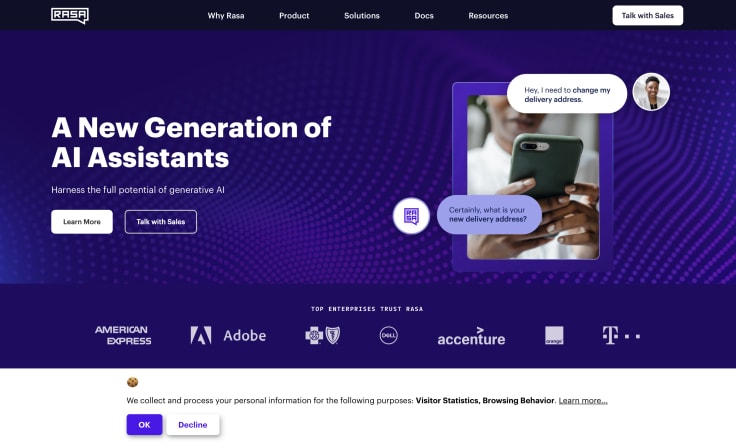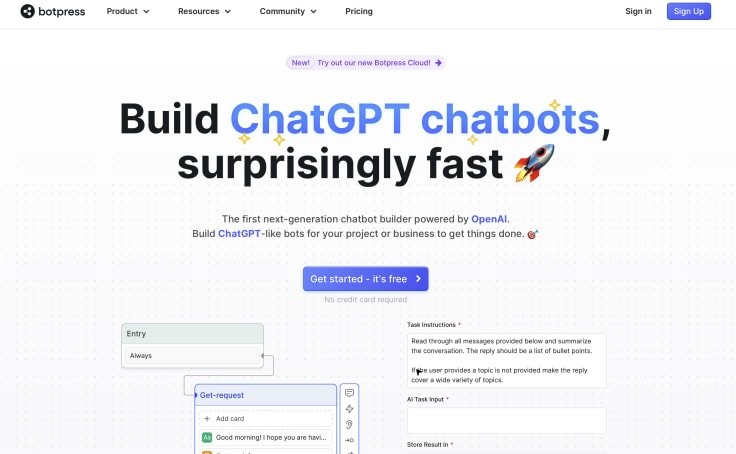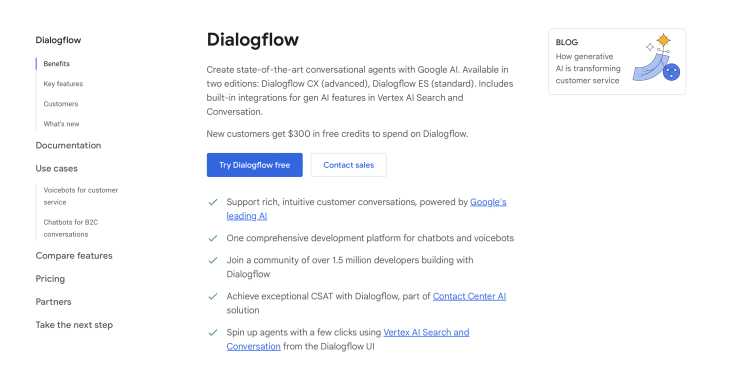Showing top 0 results 0 results found
Showing top 0 results 0 results found

Businesses are always searching for new and creative methods to improve customer service and engagement.
Chatbots have gained popularity in recent years. AI-powered conversational bots have become indispensable for promptly and effectively handling client inquiries.
Let’s examine a number of open-source chatbot frameworks available.
Understanding chatbot frameworks
Understanding the core ideas underlying the field of chatbot creation is crucial before delving deeply into open-source chatbot frameworks.
A chatbot framework is the structural foundation for building chatbots. It offers developers a standardized set of tools, libraries, and guidelines to simplify the frequently complex development process.
Here are the fundamental elements and ideas that characterize chatbot frameworks:
1. Foundation for conversational intelligence
A chatbot framework is fundamentally what gives apps the ability to incorporate conversational intelligence. Chatbots need conversational intelligence in order to communicate with people in a meaningful way, comprehending their input and offering relevant responses.
By providing a structured framework, the chatbot's developers may concentrate on creating unique features and user interfaces while leaving the underlying complexity of language processing and machine learning to be handled by the framework.
2. Tools and libraries
A number of tools and libraries are included with chatbot frameworks to speed up the development process. Natural language processing (NLP), machine learning (ML) algorithms, dialogue management systems, and connections with outside services are just a few of the many features that these technologies may have.
These technologies are used by developers to improve the chatbot's comprehension of user input, context adaptation, and contextually relevant response delivery. Pre-built libraries are readily available, which speeds up development and makes it possible to integrate sophisticated functionality without having to start from scratch.
3. Natural language processing
NLP integration is a key component of chatbot frameworks. The goal of NLP, a branch of artificial intelligence (AI), is to make it possible for computers to comprehend and interpret human language in a way that makes sense in context.
NLP algorithms are used in chatbot frameworks to interpret user inputs, extract intent, and identify entities. This enables the chatbot to understand the subtleties of human language and respond appropriately. One important factor determining how well a chatbot interacts with users is its NLP algorithms' sophistication.
4. Machine learning algorithms
In order for chatbots to learn from and adjust to user interactions, machine learning is an essential component of chatbot frameworks. Over time, these algorithms help the chatbot better grasp the user's intent, enabling it to respond with greater accuracy and contextual relevance. Machine learning algorithms make continuous optimization possible, which guarantees that the chatbot improves and changes with every interaction.
5. Streamlining development processes
A chatbot framework's main goal is to expedite the development process by offering a uniform and organized environment. By leveraging the framework, developers can avoid having to create the wheel for basic functionalities and instead concentrate on customizing the chatbot to meet unique business requirements. Process simplification shortens development times, lowers the possibility of mistakes, and improves the general effectiveness of creating and using chatbots.
Give ChatBot a try with our 14-day FREE trial.
The landscape of open-source chatbot frameworks
Rasa
Rasa distinguishes itself in the open-source chatbot market by prioritizing sophisticated natural language understanding (NLU) functionalities. Using Rasa, developers can create intelligent and contextual chatbots beyond basic Q&A exchanges. Because of the framework's strong NLU engine, chatbots can understand user inputs more deeply and provide context-aware, more relevant responses. Rasa also allows voice and text interactions, which expands the opportunities for developers looking for a flexible solution.

ChatterBot
ChatterBot has an innovative approach with an open-source framework based on Python that combines machine learning algorithms and rule-based methodologies. With this combination, programmers can build chatbots that can have more organic and lively dialogues.
While ChatterBot's machine-learning techniques enable it to adapt and respond to user inputs in a way that mimics human-like conversation, its rule-based approach lays the groundwork for organized interactions. This framework is especially appropriate for applications where dynamic and ever-changing conversations are crucial.
Botpress
One of Botpress's unique selling points is its modular architecture, which gives programmers an effective and adaptable chatbot-building platform. Because of the framework's modular design, developers may plug and play chatbot capabilities together to increase flexibility and scalability.
As it accommodates developers of different skill levels and offers a visual interface for building chatbot processes, Botpress is a viable choice for individuals just starting out in the chatbot development space. Because of its focus on modularity, Botpress is a compelling option for companies whose needs for chatbots change over time.

Microsoft Bot Framework
The Microsoft Bot Framework is a feature-rich solution that is compatible with numerous programming languages and was created by Microsoft. In addition to being multilingual, the framework provides several features designed specifically for creating chatbots that function well with various platforms, such as Skype and Microsoft Teams.
The Microsoft Bot Framework is a great option for companies looking for a single chatbot solution that can serve a wide range of user bases through various communication channels because of its cross-platform interoperability. Its integration features further enhance the framework's affinity for businesses integrated into the Microsoft ecosystem.
Dialogflow
Google owns Dialogflow, an open-source chatbot development platform that is popular and well-liked for its user-friendly interface. Because it is designed with user-friendliness as its top priority, developers of all skill levels can use this platform. The power of Dialogflow resides in its ability to easily integrate with a wide range of platforms, giving companies the freedom to select the channels by which their chatbots communicate with customers.
Dialogflow offers a uniform and user-friendly experience, whether implemented on webpages, messaging apps, or voice-activated devices. Dialogflow's adaptability makes it the perfect option for companies with a range of integration requirements.

ChatBot - a comprehensive solution
Within the chatbot space, ChatBot stands out as a feature-rich, user-focused platform that solves many issues with open-source frameworks.
Let's examine the unique benefits and features that make ChatBot unique:
1. Quick and accurate AI-generated answers
ChatBot excels at responding to client inquiries quickly and accurately by incorporating AI algorithms. Chatbots developed with this tool can comprehend user inputs more deeply thanks to the platform's NLP features, which guarantee that the responses are timely and relevant to the context. This ability to produce precise responses adds to a smooth and fulfilling user experience, increasing the chatbot's overall efficacy.
2. No coding chatbot setup
ChatBot's dedication to accessibility via a no-code interface is one of its most notable characteristics. With a less complicated setup approach than standard open-source frameworks, ChatBot gives enterprises the advantage. By enabling people with a variety of skill sets inside an organization to actively engage in creating and deploying chatbots, this no-code approach democratizes the process of developing chatbots. In addition to speeding up deployment, this democratization of the development process lowers entry hurdles for companies looking to take advantage of conversational AI.
3. Faster 24/7 support
Outstanding customer service is defined by the need for round-the-clock assistance, and ChatBot helps companies to easily provide this requirement. Its effective architecture guarantees that chatbots developed on this platform can offer customers 24/7 assistance. This feature quickly responds to questions and concerns and goes above and beyond regular business hours and greatly increases customer satisfaction. It works regardless of the user's location or time zone. The outcome is an improved degree of assistance and involvement consistent with the always-on character of the digital age.
4. No dependencies on third-party providers
One of ChatBot's unique selling points is its self-contained ecosystem, which eliminates reliance on third-party suppliers like OpenAI, Google Bard, or Bing AI. This independence guarantees a dependable and smooth experience for end users as well as companies. Because ChatBot doesn't rely on outside suppliers, it reduces the possibility of external disruptions, enhancing the chatbot deployment's stability and dependability. Companies can confidently launch their chatbots because the ChatBot platform encompasses the entire ecosystem.
5. Data security
The protection of user data is our primary priority. The platform processes and hosts all data only in its secure environment, strictly protecting data. This closed-loop technology reassures users and companies that their sensitive data stays inside the ChatBot platform by reducing the dangers involved in data transport and storage. This dedication to data security promotes confidence between companies and their clients by being compliant with industry standards and laws.
Chatbot framework comparison
Businesses must carefully weigh their alternatives in the ever-changing chatbot development landscape to make decisions that best suit their specific requirements.
This section will compare ChatBot to well-known open-source frameworks in-depth, analyzing critical elements that affect the efficacy and efficiency of chatbot deployments.

1. Ease of use
Even if they are strong, open-source frameworks frequently require developers to have technical knowledge. For those with programming expertise, developing chatbots may be more accessible due to the steep learning curve linked with these frameworks.
ChatBot, on the other hand, stands out for its dedication to simplicity via a no-code interface. Because of the platform's user-friendly design, people with different degrees of technical expertise may create and use chatbots without having to know a lot of coding.
A wider audience within a company can create chatbots because of this democratization of the development process, which speeds up deployment and lessens the need for expert technical resources.
2. Customization options
Due to the wide range of customization options offered by open-source frameworks, developers can precisely adjust each facet of the chatbot's functionality. However, coding knowledge is frequently required for this degree of customization.
ChatBot offers extensive widget customization capabilities without requiring users to know how to code, striking a compromise between accessibility and customization. With customization choices for the chatbot's behavior, style, and interactions, the platform's user-friendly interface gives businesses the freedom to design a chatbot that fits their unique needs and brand.
3. Scalability
The fundamental architecture of open source frameworks and their capacity to effectively manage growing loads and changing business requirements are frequently what define their scalability. These frameworks may need to have their infrastructure changed and further development work done in order to scale.
With scalability in mind, ChatBot provides organizations with a platform that can easily expand to meet their needs. ChatBot's infrastructure is designed to accommodate growing usage and changing needs without sacrificing performance. This guarantees that companies can easily grow their chatbot operations as their user base grows or their needs for conversational AI change.
4. Integration capabilities
The degree to which open-source frameworks can be seamlessly integrated with current systems may differ, and this may call for further development work. For enterprises, compatibility with widely used platforms and apps can make a big difference.
ChatBot includes a number of integrations with popular tools, including Shopify, Slack, and WordPress, enabling companies to easily include their chatbots into a range of platforms and apps. The tool offers a flexible solution to meet the various integration requirements of organizations, be it ecommerce platforms, messaging apps, or customer relationship management (CRM) systems. By doing this, the chatbot's impact and efficacy are increased and it is certain to become a crucial component of the entire digital ecosystem.
Case studies and success stories
Let’s now examine chatbot use cases to highlight the advantages of using chatbots.
These examples will show how companies from a range of industries use chatbots to accomplish amazing outcomes that improve customer happiness and maximize operational efficiency.
1. Retail industry: enhancing customer engagement
Chatbots are valuable tools in the retail industry, serving to enhance customer experiences and boost operational efficiency. They can respond quickly and accurately to customer inquiries, handle orders and returns, and offer personalized product recommendations based on individual preferences. Examples include virtual makeup try-ons, fashion advice, and order tracking.
AI-powered retail chatbots go a step further, analyzing customer data for even more personalized interactions and advanced problem-solving. These tools play a crucial role in improving customer service, increasing sales, and streamlining various aspects of retail operations.
2. Healthcare sector: empowering patients with chatbots
Within the medical field, telehealth service providers can improve patient accessibility and fast information delivery with a chatbot for healthcare. Creating a chatbot with extensive customization possibilities enables users to book appointments, get prescription reminders, and obtain general health information. The outcomes may include better patient engagement, lighter administrative loads, and more operational efficiency for healthcare professionals.
3. Financial services: security and compliance
Chatbots play a crucial role in financial services by providing efficient customer support, handling routine inquiries, and facilitating transactions. They contribute to improved customer experiences with quick responses and personalized assistance in areas such as account inquiries and transaction history.
Security measures are reinforced through authentication processes embedded in chatbots, ensuring secure access to sensitive information. Compliance with financial regulations is addressed through carefully programmed responses and adherence to industry standards, ensuring that interactions meet legal and ethical requirements.
4. Travel and hospitality: scalability with chatbots
The travel industry can also benefit from chatbots by enhancing customer service, streamlining processes, and providing personalized assistance. Chatbots for the travel and hospitality sector efficiently handle booking inquiries, reservation changes, and travel itineraries, reducing response times and enhancing overall customer satisfaction.
Chatbots also provide real-time travel updates, such as flight status and weather conditions, contributing to a smoother travel experience. Through AI-driven analysis, chatbots can offer personalized accommodations, activities, and transportation recommendations, tailoring suggestions to individual preferences.
5. Technology and SaaS: integration excellence
In the realm of technology and SaaS operations, chatbots offer significant improvements by enhancing customer support and automating routine tasks. They facilitate quick resolution of customer queries, provide technical assistance, and offer troubleshooting guidance, leading to improved user satisfaction.
Chatbots streamline processes by automating repetitive tasks such as software updates, account management, and data retrieval. They also contribute to proactive engagement by sending alerts, notifications, and updates. With advanced analytics capabilities, AI-driven chatbots can also assist in data analysis, reporting, and trend identification.
Create your next conversational bot with ChatBot 2.0
Selecting a chatbot architecture becomes crucial as companies grow to understand how valuable chatbots can be in improving consumer relations.
Although open-source frameworks provide freedom, ChatBot's user-friendly interface, robust functionality, and dedication to data protection make it an attractive alternative.



